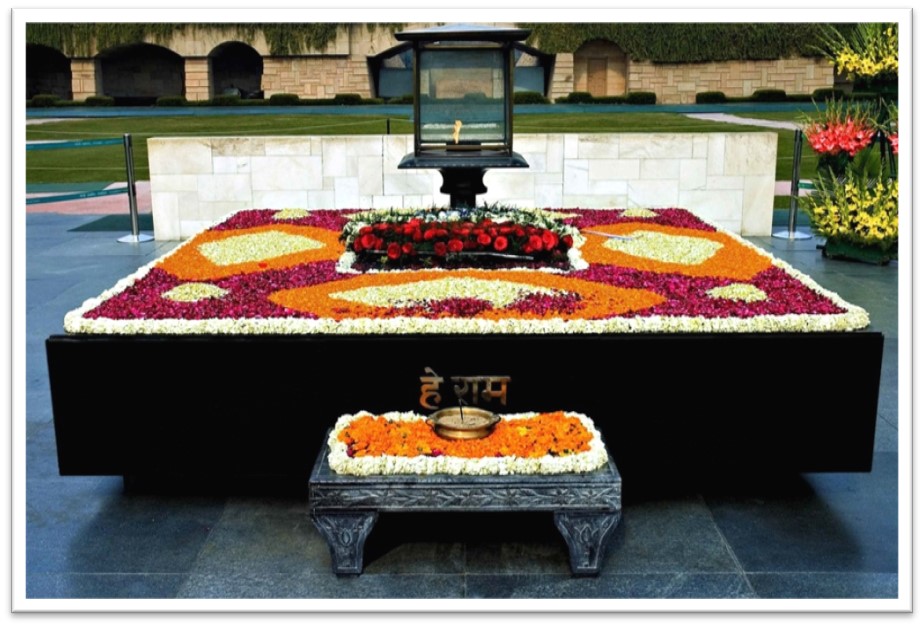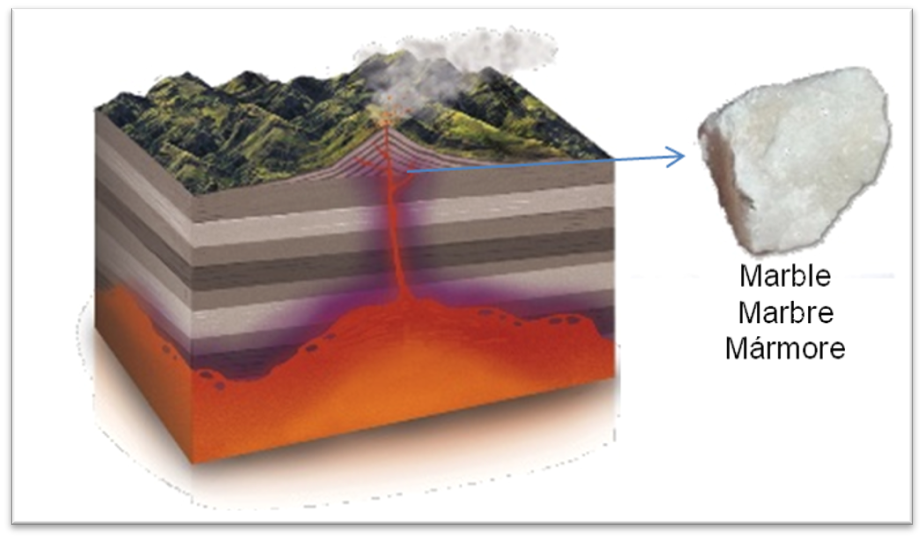The marble of Gandhi
Raj Ghat:
Raj Ghat is a place where is situated the memorial to Mahatma Gandhi (Mohandas Karamchand Gandhi – born on 2 October 1869 in Porbandar, and assassinated in the garden of the former Birla House – actually Gandhi Smriti, at 5:17 pm on 30 January 1948), and originally it was the name of a historic ghat (refers to a series of steps leading down to a body of water) of Old Delhi (Shahjahanabad). The memorial to Gandhi is a black platform that marks the spot of Mahatma Gandhi’s cremation, Antyesti (Antim Sanskar), on 31 January 1948, a day after his assassination. Antyesti literally means “last sacrifice”, and refers to the funeral rites for the dead in Hinduism. Above this black platform is left open to the sky an eternal flame that burns perpetually. At Raj Ghat area exist other associated memorials. Some examples of them are: Jawaharlal Nehru, Lal Bahadur Shastri, Indira Gandhi, and others.
F – Raj Ghat: Raj Ghat est une place où c’est un mémorial au Mahatma Gandhi (Mohandas Karamchand Ghandi – né le 2 octobre 1869 à Porbandar, et a été assassinée dans le jardin de la Birla House – maintenant Gandhi Smriti, à 17 heures et 17 minutes du 30 janvier 1948), et à l’origine ce fut le nom du ghat historique (qui se réfère à une série d’escaliers à un plan d’eau) dans l’Old Delhi (Shahjahanabad). C’est une simple plateforme noire qui marque l’endroit de la crémation (Antyesti ou Antim Sanskar) de Mahatma Ghandi le 31 janvier 1948, le lendemain de son assassiner. Antyesti signifie littéralement «l’ultime sacrifice» et se réfère aux rituels funéraires de l’hindouisme. Au-dessus de cette plateforme noire, elle est exposée une flamme éternelle qui brûle perpétuellement. Dans la région du Raj Ghat, il y a d’autres mémoriaux. Quelques exemples de ces sont les mémoriaux à: Jawaharlal Nehru, Lal Bahadur Shastri, Indira Gandhi, et d’autres.
P – Raj Ghat: Raj Ghat é um local onde se encontra um memorial a Mahatma Gandhi (Mohandas Karamchand Ghandi – nascido a 02 de outubro de 1869 em Porbandar, e assassinado no jardim da Birla House – atualmente Gandhi Smriti, às 17 horas e 17 minutos do dia 30 de janeiro de 1948), e originalmente este era o nome da histórica ghat (que se refere a uma série de escadas até um corpo de água) da Velha Delhi (Shahjahanabad). É uma plataforma negra que marca o local onde Mahatma Ghandi foi cremado, Antyesti (Antim Sanskar), a 31 de janeiro de 1948, um dia após o seu assassinato. Antyesti literalmente significa “o último sacrifício”, e refere-se a rituais fúnebres no Hinduísmo. Acima desta plataforma preta está exposta uma chama eterna que arde perpetuamente. Na área do Raj Ghat existem outros memoriais. Alguns exemplos destes são os memoriais a: Jawaharlal Nehru, Lal Bahadur Shastri, Indira Gandhi, e outros.

The marble of Gandhi:
The memorial to Mahatma Gandhi is composed of a black marble platform with an eternal flame. The word “marble” derives from the greek μάρμαρον (mármaron), and means “crystalline rock, shining stone”, maybe from the verb μαρμαίρω (marmaírō), “to flash, sparkle, gleam”. Marble is a non-foliated rock resulting from metamorphism (transformation of mineral composition, texture and microscopic structure of other types of pre-existing rocks) of sedimentary carbonate rocks, most commonly limestone or dolomite rock. Depending on the composition of their mineral, marble may exhibit various textures and colors, such as pink, white, green, black and others. These features make the marble, a very used material in decorations, ornaments, sculptures, and civil buildings, as seen in Raj Ghat.
F – Le marbre de Gandhi: Le mémorial au Mahatma Gandhi est composé pour une plateforme de marbre noir avec une flamme éternelle. Le mot «marbre» dérive du grec μάρμαρον (mármaron), ce qui signifie «roche cristalline, pierre resplendissante», peut-être de la dérivation du verbe μαρμαίρω (marmaírō), «clignoter, éclat, lueur». Le marbre est une roche non feuilletées résultant du processus de métamorphisme (transformation de la composition minérale, la texture et la structure microscopique d’autres types de roches préexistantes) de roches sédimentaires carbonatée, le plus souvent calcaire ou dolomie. Selon la composition de ses minéraux, le marbre peut présenter différentes textures et de couleurs, comme le rose, blanc, vert, noir et autres. Ces caractéristiques font de marbre, un matériau très utilisé dans les décorations, des ornements, des sculptures et des bâtiments civils, comme on le voit dans le Raj Ghat.
P – O mármore de Gandhi: O memorial a Mahatma Gandhi é composto por uma plataforma de mármore preto com uma chama eterna. A palavra “mármore” deriva do grego μάρμαρον (mármaron), e significa “rocha cristalina, pedra brilhante”, talvez do verbo μαρμαίρω (marmaírō), “faísca, brilho”. O mármore é uma rocha não foliada que resulta do processo de metamorfismo (transformação da composição mineral, textura e estrutura microscópica de outros tipos de rochas pré-existentes) de rochas sedimentárias carbonadas, mais comumente rochas calcárias ou dolomite. Dependendo da composição dos seus minerais, o mármore pode apresentar variadas texturas e cores, como rosa, branca, esverdeada, preta, entre outras. Estas características fazem do mármore, um material muito usado em decorações, ornamentações, esculturas, e construções civis, como se vê no Raj Ghat.

Formation of marble / Formation de marbre / Formação do mármore.
The earthcache:
As for all the earthcaches there is no container to find or physical logbook to sign, in this coordinates and spot. In front of the memorial to Mahatma Gandhi, send me by email (in profile) the answers to the following questions to validate the earthcache:
1) In memorial’s place, you can see more than one marble type. Where can you identify that marbles?
2) Characterize each of the marbles mentioned above.
3) The memorial’s top consists of black marble. What are the dimensions of each block of black marble?
4) Add a photography of you or gps in the spot. It is welcome but optional.
The "Found it" logged without sending answers will be deleted. We hope you enjoy the place.
F – L’earthcache: Comme pour toutes les earthcaches il n’y a pas de conteneur à trouver ou logbook physique à signer aux coordonnées et place. En front du mémorial au Mahatma Gandhi, répondez aux questions suivantes pour l’enregistrement de cet earthcache:
1) Dans la place du mémorial peut être vu plus d’un type de marbre. Où pourrez-vous observer ces marbres?
2) Caractérise chacun des marbres mentionnés ci-dessus.
3) Le sommet du mémorial se compose de marbre noir. Quelles sont les dimensions de chaque bloc de marbre noir?
4) Ajouter une photo de vous ou de votre gps dans la place. La photographie est bienvenue, mais non obligatoire.
Les "Found it" enregistrés sans envoi de réponses pour l’owner seront supprimés. Nous espérons que vous avez du plaisir au visiter ce place d’adoration.
P – A earthcache: Como para todas as earthcaches, não existe um container ou logbook físico para encontrar nas coordenadas. Em frente do memorial a Mahatma Gandhi, responda às seguintes questões para registar esta earthcache:
1) No local do memorial podem-se ver mais que um tipo de mármore. Onde se podem observar esses mármores?
2) Caracterize cada um dos mármores referidos anteriormente.
3) O topo do memorial é composto por mármore negro. Quais as dimensões de cada bloco de mármore negro?
4) Adicione uma fotografia sua ou com o gps no local. A fotografia é bem-vinda, mas opcional.
O registo do “Found it” sem o envio das respostas por email para o owner, implica a eliminação do mesmo. Esperemos que apreciem este local de adoração.

Source/Fonte:
- Antunes, Cristina; Bispo, Manuela; Guindeira, Ana (2015). Descobrir a terra 7 – Ciências naturais. Lisboa: Areal Editores.
- Todd, Anne (2004). Spiritual leaders and thinkers: Mohandas Gandhi. Philadelphia: Chelsea House Publishers.
- King, Chris (2010). The planet we live on: The beginnings of the earth sciences. Learning Development Institute.
- wikipedia.org.
- Wolpert, Stanley (2002). Gandhi’s Passion: The life and legacy of Mahatma Gandhi. Oxford: Oxford University Press.